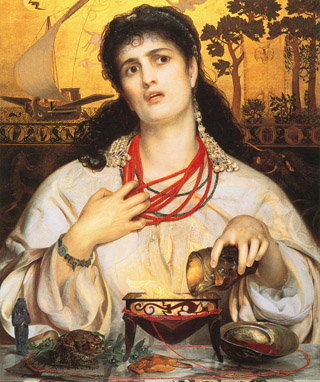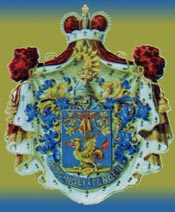
Myths and Legends
As a land with an ancient history, Samegrelo has a wealth of folk tales, myths, and legends, dating from antiquity through Christian times. Probably the most famous pre-Christian myth dealing with the land of Samegrelo is the story of Jason and the Argonauts. Among the later Christian myths of the region, many focus on the power of relics associated with the Virgin Mary, mother of Jesus and a special figure in Georgian Christianity.
The Myth of Jason and Medea
One of the great mythical stories of antiquity was the saga of Jason and his quest for the Golden Fleece. Much of the action takes place in the Kingdom of Colchis, which long ago occupied the territory of modern Samegrelo. The tale was first written down by Apollonius of Rhodes in third century BCE; its outlines follow.
 |
Jason was the son of Aeson, the rightful King of Iolcus, who was deposed and imprisoned by his half-brother Pelias while Jason was still in the womb. When Jason was born, Aeson’s wife tricked Pelias into believing the child had been stillborn, and smuggled the infant out of the palace.
Jason was reared by the Centaur Chiron, and returned to Iolcus as a young man to reclaim his family’s throne. Pelias consented to give up the throne if Jason completed a perilous task: to retrieve the legendary Golden Fleece from the realm of King Aeetes in Colchis, where it hung from a tree, guarded by a dragon that never slept. Jason agreed to the challenge, and sought out 50 of Greece’s finest men to crew his ship, the Argo.
After surmounting many obstacles along the way, the Argo reached Colchis. There, King Aeetes agreed to hand over the Golden Fleece if Jason could successfully perform a seemingly impossible feat: to harness two fire-breathing bulls, plough a field with them, and sow the field with dragons’ teeth. In this task, however, Jason had help from an unlikely source—Aeetes’s own daughter Medea, a powerful sorceress who had fallen in love with Jason. She furnished Jason with a potion that protected him from the bulls’ fire, and Jason was able to subdue the bulls and sow the fields.
Unfortunately, Aeetes had no intention of relinquishing the Golden Fleece, and sought to break his bargain with Jason. Medea rescued Jason’s quest from ruin by showing him the way to the Golden Fleece and giving him another elixir, which put the Fleece’s guardian dragon to sleep.
The Argonauts then set sail back to Iolcus, but their return was blocked by Aeetes’s fleet. Medea’s resourcefulness again saved the day. She sent a message to her brother Apsyrtus, saying she had been kidnapped, and begging him to come to a certain island to rescue her. When Apsyrtus responded to her entreaty, she murdered him, dismembered his body, and cast his remains into the sea—knowing that this would give Jason time to escape as Aeetes gathered his son’s remains.
Upon returning to Iolcus, Jason discovered that the usurper Pelias had tricked Jason’s imprisoned father, the deposed King Aeson, into committing suicide, by telling him that the Argo had gone down and Jason had failed in his quest. For this transgression, Medea contrived a gruesome form of revenge. She told Pelias’s two daughters that they could make their aged father young again through a magical ritual that required chopping the old man into pieces and placing the pieces in a boiling cauldron. To convince the skeptical siblings, she cut up an old sheep and placed the pieces in a boiling vessel before their eyes—whereupon a young, strong lamb leaped out. The demonstration was all subterfuge, but the sisters were convinced, and enthusiastically dismembered their own father and cast the pieces of his body into a boiling pot. When he failed to emerge as planned, Jason and Medea fled to Corinth to escape the wrath of Pelias’s son Acastus.
After several years and two children with Medea, Jason fell in love with Creusa, the young daughter of the King of Corinth, and left Medea to marry the princess. Once again displaying a rare talent for retribution, Medea sent Creusa a special wedding present: a robe that burst into flame when the princess put it on, killing her. When Creusa’s father, King Creon, tried to save her, he too was burned to death. Medea then murdered her own two children, fearing that they would be tortured or enslaved for their mother’s crime, and fled to Athens. In some versions of the tale, Medea later returned to Colchis, where she regained her father’s favor by killing a usurper to his throne.
The Mantle of the Blessed Virgin
Georgia embraced Christianity not long after the Roman Empire. In 327 AD (or possibly even earlier), King Mirian II of the western Georgian Kingdom of Iberia made it an official state religion. In the following decades and centuries, Orthodox Christianity established itself as a central part of Georgia’s cultural identity.
According to Christian tradition, Georgia belongs to the blessed Virgin Mary, the mother of Jesus. To this day, a sacred garment said to have been worn by Mary is kept in a special tower at the Dadiani Palace Museum in Zugdidi, Samegrelo. It is brought out once a year—on the Feast of the Blessed Virgin of Vlakerni—and displayed so that worshippers may touch it and pray. It is not know exactly how this relic of the Virgin ended up in Zugdidi, and several stories about the garment’s history exist, the general outlines of which follow.
During the reign of the Byzantine Emperor Leon the Great (457-471), the emperor’s brothers—the clerics Galvius and Candid—made a pilgrimage to the holy lands to visit scared sites. In the village of Nazareth, the birthplace of Jesus, they stayed in a modest private house, where they noticed to their surprise that a number ill people were lying on the floor in the inner room amidst burning candles. The house’s owner told them that a holy garment of the Virgin Mary, which had been passed down among believers for generations, was kept in a chest in the room. The brothers then fashioned a chest that resembled the one in which the holy relic was stored, and switched the chests when no one was present. They returned to Constantinople with their prize, where the emperor was delighted with the holy treasure they brought to him. He had the garment placed in the Vlakerni Church of the Blessed Virgin, his de facto court church. Nearly a millennium later, the garment, along with other sacred relics, was brought to Georgia by an archbishop fleeing Constantinople after the city’s fall to the Ottomans in 1453.
Many miracles are attributed to the mantle of the Blessed Virgin. One relates that in 626, a huge army of Persians and Khazars under the command of Shah Varaz surrounded Constantinople. At the time, the Byzantine Emperor Heracles was engaged in another battle, and the defense of the city was left to Patriarch Serge, who took the garment and other holy relics and walked around the city walls, praying for deliverance. When the enemy attacked from the sea, the city walls were quickly breached and the invading army marched in to claim the city. However, as the enemy host approached the Church of the Blessed Virgin, powerful winds blew down from the heavens and halted them in their tracks. At the same time, these miraculous winds whipped up huge waves that sank many of the enemy’s vessels. Shah Varaz’s terrified troops had no choice but to fall back from the divinely protected city.
This was the first of several occasions when the power of the Blessed Virgin’s garment was said to have saved Constantinople. According to legend, another of these occasions took place in 866, when two pagan Russian warlords, Askold and Rit, sailed for Constantinople with a fleet of 200 armed vessels. Again, the Byzantine Emperor was off fighting other battles, and the Patriarch was in charge of the city. On this occasion, he brought the Virgin’s garment out of the church and dipped it into the sea, whereupon a howling gale arose on the waters, sinking and scattering the Russian armada. Seeing the power against which they were fighting, Askold and Rit repented and converted to Christianity.
[ TOP ]
